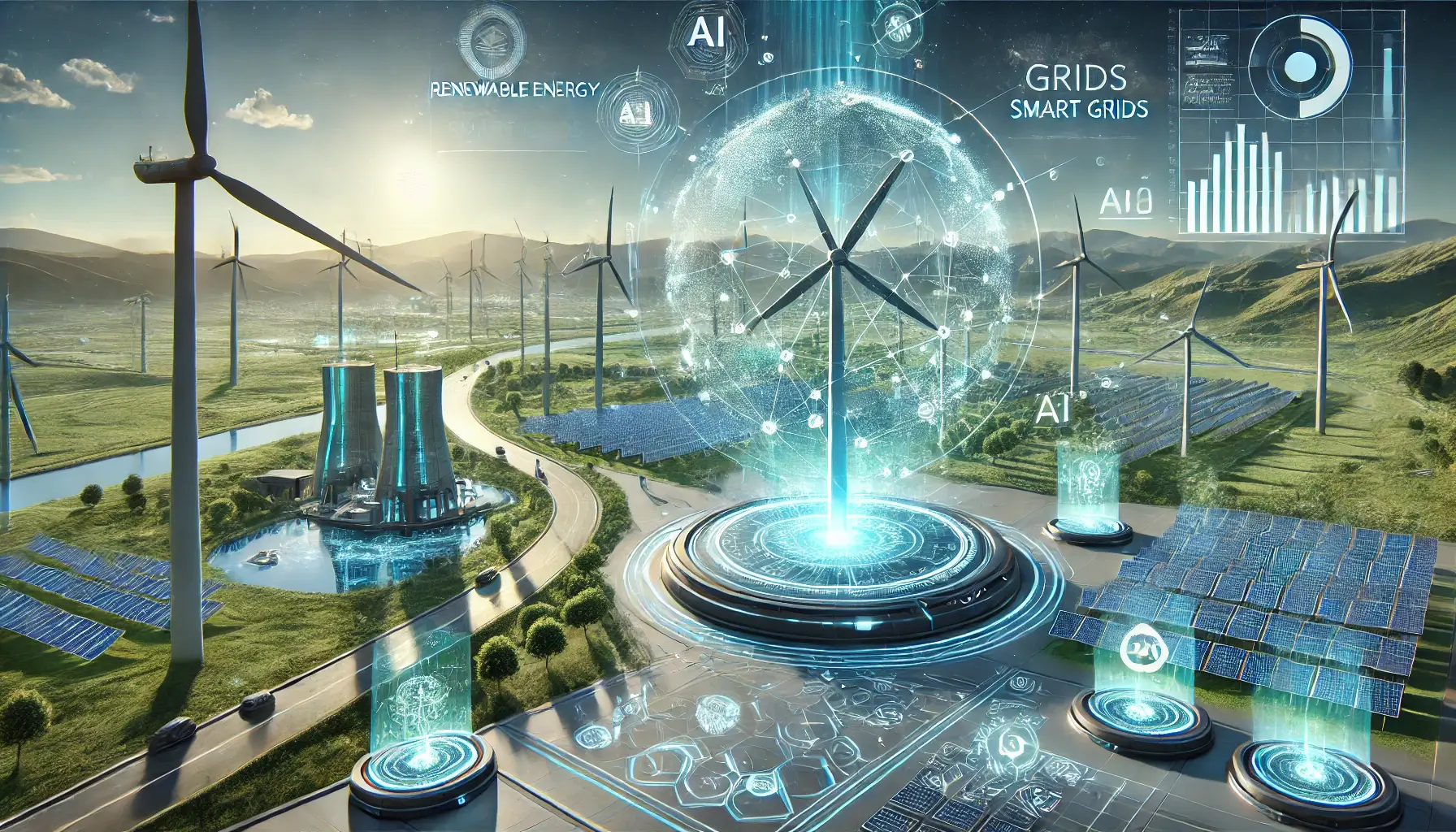-
How Digital Nomads Are Redefining Work and Lifestyle 🌍💻
Mar 06, 2025 | 38 Comments -
How Artificial Intelligence is Transforming Healthcare 🏥🤖
Mar 06, 2025 | 0 Comments -
How Cryptocurrency is Reshaping the Global Economy 💰🌍
Mar 06, 2025 | 0 Comments -
How to Build a Strong Personal Brand: Stand Out & Grow Your Influence 🚀📢
Mar 02, 2025 | 0 Comments -
The Power of AI in Business: How Artificial Intelligence is Transforming Industries 🚀🤖
Mar 02, 2025 | 0 Comments -
How Smart Homes Are Changing the Way We Live 🏡🔋
Mar 02, 2025 | 0 Comments -
How Electric Vehicles Are Revolutionizing Transportation 🚗⚡
Mar 02, 2025 | 0 Comments -
The Future of Renewable Energy: How Green Technology is Changing the World 🌍⚡
Mar 02, 2025 | 0 Comments

The Future of Renewable Energy: AI, Smart Grids, and Sustainable Innovations
Renewable energy is rapidly becoming the backbone of global power systems, with artificial intelligence (AI), smart grids, and energy storage innovations driving sustainability. As the world shifts away from fossil fuels, advancements in clean energy technologies are improving efficiency, reliability, and accessibility. The future of renewable energy relies on AI-driven optimization, smart grid infrastructure, and sustainable solutions.
The Role of AI in Renewable Energy
AI is transforming the renewable energy sector by optimizing power generation, predicting demand, and improving efficiency.
1. AI-Powered Energy Forecasting
Machine learning predicts weather conditions and energy output for better grid management.
- AI analyzes weather data to optimize solar and wind power generation.
- Predictive models adjust energy storage to balance supply and demand.
- AI prevents energy waste by forecasting grid requirements.
2. AI-Driven Smart Grids
Smart grids use AI to optimize electricity distribution and reduce energy loss.
- AI-powered load balancing prevents power outages.
- Real-time analytics detect grid failures and automate repairs.
- AI enhances energy efficiency by optimizing power distribution.
3. AI in Renewable Energy Maintenance
AI-powered maintenance systems detect faults in renewable energy infrastructure.
- AI identifies potential failures in wind turbines and solar panels.
- Automated monitoring reduces downtime and repair costs.
- Machine learning improves long-term efficiency predictions.
Smart Grids and the Future of Energy Distribution
Smart grids improve energy management by integrating renewable sources and storage systems.
1. Decentralized Energy Distribution
Decentralized grids allow local energy generation and consumption.
- Microgrids supply energy to remote areas without relying on central grids.
- Peer-to-peer energy trading enables consumers to sell excess power.
- Blockchain ensures secure and transparent energy transactions.
2. AI-Optimized Demand Response
AI-driven demand response systems improve energy efficiency.
- Smart grids adjust electricity flow based on real-time consumption.
- AI identifies peak demand periods and redistributes power efficiently.
- Predictive analytics prevent energy shortages and surpluses.
3. Smart Meters and IoT Integration
IoT-connected smart meters provide real-time energy usage data.
- Consumers monitor and optimize energy consumption.
- Utilities adjust pricing based on real-time demand.
- AI-driven analytics improve grid reliability and efficiency.
Innovations in Renewable Energy Technologies
Advancements in solar, wind, and energy storage are making renewables more viable.
1. Next-Generation Solar Power
Solar technology is evolving with increased efficiency and affordability.
- Perovskite solar cells offer higher energy conversion rates.
- Floating solar farms maximize space utilization on water bodies.
- AI optimizes solar panel positioning for maximum sunlight absorption.
2. Wind Energy Advancements
Wind energy is becoming more efficient with AI-driven solutions.
- AI predicts wind patterns for optimal turbine placement.
- Offshore wind farms increase power generation potential.
- Smart sensors detect turbine faults and automate maintenance.
3. Energy Storage Breakthroughs
Innovative storage solutions ensure stable renewable energy supply.
- Solid-state batteries enhance storage capacity and safety.
- Hydrogen fuel cells provide long-term clean energy storage.
- Pumped hydro storage balances grid supply during peak hours.
The Role of Policy and Investment in Renewable Energy
Government policies and private investments drive renewable energy adoption.
1. Government Incentives for Clean Energy
Governments offer incentives to promote renewable energy development.
- Tax credits reduce installation costs for solar and wind projects.
- Green energy subsidies support emerging clean technologies.
- Regulations encourage utilities to transition to sustainable sources.
2. Corporate Investment in Sustainability
Businesses are committing to renewable energy to reduce carbon footprints.
- Tech companies invest in 100% renewable-powered data centers.
- Manufacturers integrate solar and wind energy into production facilities.
- Retailers adopt sustainable supply chain practices.
3. The Role of Carbon Trading
Carbon trading markets promote emissions reductions and clean energy adoption.
- Companies buy and sell carbon credits to offset emissions.
- Renewable energy projects generate valuable carbon offsets.
- AI tracks emissions data for accurate carbon credit reporting.
Challenges Facing Renewable Energy Adoption
Despite growth, renewable energy faces challenges that need to be addressed.
- Energy Storage Limitations: Batteries must improve for better grid stability.
- Infrastructure Costs: Upgrading power grids requires significant investment.
- Intermittency Issues: Solar and wind energy depend on weather conditions.
- Regulatory Barriers: Some regions face slow policy adoption for renewables.
Future Predictions for Renewable Energy
The next decade will see renewable energy dominating global power generation.
1. AI-Enhanced Energy Efficiency
AI will continue improving energy efficiency and sustainability.
- Smart grids will autonomously adjust energy distribution.
- AI will optimize battery storage and energy usage.
- Automated energy trading will balance grid demand.
2. Global Transition to 100% Renewable Energy
Countries will commit to fully renewable power systems.
- Solar and wind energy will replace fossil fuel plants.
- Hydrogen fuel cells will power industries and transportation.
- Decentralized microgrids will improve energy access worldwide.
Conclusion
Renewable energy is the future of global power, with AI, smart grids, and energy storage driving the transition. Businesses, governments, and individuals must embrace clean energy solutions to ensure a sustainable and carbon-free future.
1 comments
Paulina Aug 26, 2025
Cabinet IQ Cedar Park 2419 Տ Bell Blvd, Cedar Park, TX 78613, United Ⴝtates +12543183528 https://list.ly/
Your comment